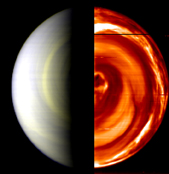|
News Notes
Planetary geology
Vortex visible on Venus
 The first
images ever taken of Venus’ south pole caused a swirl of excitement
among astronomers in April. Taken by cameras aboard the European Space
Agency’s Venus Express spacecraft, the images revealed that hovering
above the southern pole is an enormous vortex structure of clouds, similar
to one found at the previously imaged north pole.
The first
images ever taken of Venus’ south pole caused a swirl of excitement
among astronomers in April. Taken by cameras aboard the European Space
Agency’s Venus Express spacecraft, the images revealed that hovering
above the southern pole is an enormous vortex structure of clouds, similar
to one found at the previously imaged north pole.
The first-ever images of Venus’ southern pole reveal a vortex structure of clouds, seen here in false color composite images from an infrared camera taken by the Venus Monitoring Camera aboard ESA’s Mars Express. The day side view is on the left, and the night side view is on the right. Image is courtesy of ESA/INAF-IASF, Rome, Italy, and Observatoire de Paris, France.
The two poles likely have differences in detail, but “broadly, it’s the same kind of thing,” says Fred Taylor, a planetary physicist at the University of Oxford in the United Kingdom, and a project scientist for the Venus Express Mission. “And that’s what we would have expected — that Venus [would] be roughly symmetrical.”
The process that forms Venus’ polar vortexes is similar to the process forming Earth’s less-defined vortices at its poles, in which a warm equator drives high equatorial winds up toward the cooler poles, where the winds become unstable. On Venus, the vortex resembles the enormous mass of turning air that we see in hurricanes, except that instead of hundreds of kilometers across, Venus’ structures span thousands of kilometers, Taylor says. Also, the vortex at Venus’ northern pole has “quite an unusual shape, not like the ones we’re used to on Earth,” he says. Instead of one centered calm spot, or “eye,” the vortex is a double structure with two eyes.
The differences could be due in part to Venus having stronger and more organized winds than those on Earth, Taylor says. Also, Venus is similar to Earth in size, but it rotates more slowly and orbits closer to the sun. “Those things make a difference, and it’s nice to see how it all responds to that,” he says.
Project scientists need a few more months of data to find out if Venus’ southern vortex shows multiple eyes, or any other minor differences from the northern pole, Taylor says. “All we can say at the moment is that it looks pretty exciting, and there’s lots of interesting detail.”
Kathryn Hansen

 Subscribe
Subscribe

